Study on Semi-Rigid Joint Performance and Stability Bearing Capacity of Disc-Type Steel Pipe Support
Abstract
1. Introduction
- (1)
- A bending stiffness test is conducted for the connection joint of Φ48-type disc-buckle steel pipe support, with the disc-buckle joint exhibiting semi-rigid connection characteristics. Meanwhile, nonlinear fitting of the test data is performed. Through quantitative analysis, a more conservative reference value for the semi-rigid calculation model of the joint is provided, and the recommended value for the bending stiffness of the semi-rigid joint is determined.
- (2)
- The finite element analysis software is utilized to numerically simulate the entire bending test process of the joint. The mechanical performance at each stage of the joint is analyzed, and a trilinear function model for the bending moment–rotation angle of the joint is proposed.
- (3)
- By combining with the test and numerical simulation results, a more conservative node stiffness value is selected to correct the effective length coefficient, and specific effective length coefficient values under various setting parameters are provided, offering data for reference in practical engineering calculations.
- (4)
- Taking an airport expansion project as the case study, the recommended values of bending stiffness of joints investigated in this paper are validated by calculating the slenderness ratio of corrected length coefficient.
2. Bending Stiffness Test of Disc-Buckled Steel Pipe Support Joint
2.1. Test Purpose
2.2. Test Scheme
2.3. Test Model
- —The displacement value generated by the bar;
- —The horizontal displacement value of the pole;
- —The vertical distance from the measuring point on the vertical bar to the axis of the horizontal bar;
- —The horizontal distance from the measuring point on the vertical bar to the measuring point on the horizontal bar.
- —The horizontal distance between the action point of the vertical concentrated force of the horizontal bar and the axis of the vertical bar;
- —The concentrated load applied vertically by the transverse bar;
- —The bending moment of the plate-buckle joint.
2.4. Experimental Data Processing
3. Finite Element Simulation Analysis
3.1. Finite Element Module Method
- (1)
- Element Selection
- (2)
- Boundary Condition
- (3)
- Constitutive Model
- —Elastic modulus;
- —True strain;
- —True stress.
- (4)
- Model Building
3.2. Numerical Simulation Results
4. Derivation of Effective Length Correction Coefficient Based on Semi-Rigid Joint
- —Bending stiffness of the horizontal bar;
- —Bending stiffness of disc-buckle joints;
- —Horizontal and vertical distance.
- (1)
- The rods consist of elastic members with uniform cross sections;
- (2)
- The axial force in the crossbar is negligibly small;
- (3)
- The rotation angles at both ends of the crossbar are equal meaning that the rotational stiffness values at both ends are identical (), and correspond to the rotational stiffness value of the plate buckle joint;
- (4)
- During the frame buckling process, both ends of the crossbar exhibit identical degrees of rotation in the same direction;
- (5)
- The connection nodes demonstrate semi-rigid behavior;
- (6)
- When buckling occurs, the moment generated at the joint by the end of the vertical bar is distributed according to the linear stiffness of the transverse bar to achieve equilibrium.
- —Horizontal and vertical distance;
- —Bending stiffness of disc-buckle joints;
- —Moment of inertia of the cross section of the bar;
- —Elastic modulus of the bar.
- —The ratio of the sum of the linear stiffness of the upper part of the horizontal bar to the sum of the linear stiffness of the vertical bar;
- —The ratio of the sum of the linear stiffness of the lower part of the horizontal bar to the sum of the linear stiffness of the vertical bar.
5. Engineering Example
5.1. Project Profile
5.2. Design Scheme of Disc-Buckle Steel Pipe Support
- (1)
- The disc-type steel pipe support has a height of 12 m and a span of 20 m.
- (2)
- Support frame dimensional specifications: pole step distance h = 1.5 m, pole vertical distance (span direction) L = 1.2 m, horizontal distance 1.2 m, top extension height a = 0.5 m.
- (3)
- Permanent load of support:
- (4)
- Bracket variable load:
- (5)
- Wind load parameters: The basic wind pressure is = 0.25 kN/m2, the ground roughness is B (urban suburbs), the height variation coefficient of wind pressure is = 1.06, and the shape coefficient of wind load is = 0.5. The standard value of wind load is calculated as follows:
- —Structure importance coefficient, 1.1;
- —Variable load partial coefficient, 1.5;
- —Variable load adjustment coefficient, 0.9;
- —Standard value of wind load, calculated 0.133 kN/m2;
- —Vertical rod length (m), 1.8 m;
- —Step distance (m), 1.5 m.
5.3. Stability Verification Calculation of Disc-Buckle Steel Pipe Support
- (1)
- Without Wind Load Consideration:
- (2)
- With Wind Load Consideration:
6. Conclusions
- (1)
- The bending stiffness tests of the joints yielded the bending moment–rotation curve for the connection joint of the Φ48-type disc-buckle steel pipe support. Based on these curve characteristics, an appropriate semi-rigid joint calculation model was selected, and nonlinear fitting of the test data was performed. Parametric analysis of the joint’s semi-rigidity determined an initial stiffness value of 48.456 kN·m/rad.
- (2)
- Finite element analysis was conducted on the Φ48-type disc-buckle steel pipe support joint to simulate the complete process of the joint bending test. Results demonstrate excellent agreement between the finite element simulation of the joint loading process and the experimental data, validating the model’s accuracy. Based on the numerical simulation results, a trilinear fitting function for the – relationship curve of the joint flexural member was derived:
- (3)
- Utilizing the theory of semi-rigid connection frames with lateral displacement, this study revised the stiffness coefficient , the constraint coefficient k at the vertical bar end, and the effective length coefficient of the vertical bar under horizontal bar end constraints, accounting for the joint’s semi-rigidity. For horizontal and vertical bars of varying dimensions, this study established the range and specific values of corresponding effective length correction coefficients for determined construction parameters.
- (4)
- Using an actual engineering project as a case study, verification of the vertical bar’s slenderness ratio under the calculated length correction coefficient revealed results 8.13% higher than standard specifications. This discrepancy arises because the effective length coefficient specified in the code does not fully account for the semi-rigid characteristics of joints resulting from the constraint effect of the crossbar in steel pipe support in actual projects. Theoretical calculations confirmed that the derived calculation length correction coefficient satisfies practical engineering requirements.
Author Contributions
Funding
Data Availability Statement
Conflicts of Interest
References
- Bing, Z.; Jian, X.; Yan, L. Study on the influence of node stiffness on the dynamic performance of spatial tubular truss arches. Build. Sci. 2022, 38, 16–26. [Google Scholar] [CrossRef]
- Yang, X.; Er, M.; Jing, M. Performance analysis of semi-rigid joints in new steel tube scaffolding. Steel Constr. 2018, 33, 144–149. [Google Scholar] [CrossRef]
- Yan, L.; Mei, R.; Wei, Z. Analysis of the causes of high-formwork collapse accidents based on the “2-4” mod-el. Constr. Saf. 2022, 37, 74–77. [Google Scholar]
- Xin, L.; Wen, L.; Kai, L. Progressive collapse prevention of engineering structures in China: Review and prospect. Build. Struct. 2019, 49, 102–112. [Google Scholar] [CrossRef]
- Chandrangsu, T.; Rasmussen, J.K. Investigation of geometric imperfections and joint stiffness of support scaffold systems. J. Constr. Steel Res. 2010, 67, 576–584. [Google Scholar] [CrossRef]
- ANSI/AISC 360-22; Specification for Structural Steel Buildings. American Institute of Steel Construction—AISC: Chicago, IL, USA, 2022.
- Li, W. Bending buckling of axially compressed members. Build. Struct. 2019, 49, 126–135. [Google Scholar] [CrossRef]
- GB50017-2017; National Standard of the People’s Republic of China. Design Standard for Steel Structure. China Building Industry Press: Beijing, China, 2018.
- Chang, H.; Yan, G.; Yuan, M.; Xiao, B. Experimental study on bearing capacity of formwork support system. J. Xi’an Univ. Archit. Technol. (Nat. Sci. Ed.) 2017, 49, 179–186. [Google Scholar] [CrossRef]
- Jing, W.; Guo, L. Stability analysis of columns in semi-rigidly connected composite frames with lateral displacement. J. Harbin Inst. Technol. 2009, 41, 126–130. [Google Scholar]
- Qing, W.; Ming, S. Lateral displacement mode of column-supported modular steel structures with semi-rigid connections. J. Build. Eng. 2022, 15, 62–64. [Google Scholar] [CrossRef]
- Cimellaro, G.P.; Domaneschi, M.; Cimellaro, P.G.; Domaneschi, M. Stability Analysis of Different Types of Steel Scaffolds. Eng. Struct. 2017, 152, 535–548. [Google Scholar] [CrossRef]
- Cheng, Q.; Kuang, X.; Zong, W.; Li, Q.; Shen, L. Bearing capacity analysis of semi-rigid supports based on energy method. Highway 2021, 66, 193–195. [Google Scholar]
- Blazik-Borowa, E.; Szer, J.; Borowa, A.; Robak, A.; Pienko, M. Modelling of load-displacement curves obtained from scaffold components tests. Bull. Pol. Acad. Sci. Tech. Sci. 2019, 67, 317–327. [Google Scholar] [CrossRef]
- Kong, R.; Lin, F.; Rang, Z.; Wang, Z.; Xu, Z. Study on the stiffness of cuplock nodes in M60 steel tube form-work supports. Ind. Constr. 2023, 1, 1–16. Available online: http://kns.cnki.net/kcms/detail/11.2068.TU.20231020.1036.004.html (accessed on 20 May 2025).
- Xiao, Q. Research on Test and Application Technology of Disc-Buckled and Bowl-Buckled Steel Tube Support Joints. Master’s Thesis, Southeast University, Nanjing, China, 2016. [Google Scholar]
- Guang, C.; Kun, H.; Lei, W.; Ye, C. Investigation of the mechanical properties of inserting-type support frames. Sci. Rep. 2024, 14, 29746. [Google Scholar] [CrossRef]
- Zhao, Z.; Liu, H.; Liang, B. Novel numerical method for the analysis of semi-rigid jointed lattice shell structures considering plasticity. Adv. Eng. Softw. 2017, 114, 208–214. [Google Scholar] [CrossRef]
- Genovese, F.; Sofi, A. A Novel Interval Matrix Stiffness Method for the Analysis of Steel Frames with Uncertain Semi-Rigid Connections. Adv. Eng. Softw. 2024, 192, 103629. [Google Scholar] [CrossRef]
- Gan, S.; Wei, L.; Shao, C. Theoretical research on direct analysis method of semi-rigid steel frames. J. Build. Struct. 2014, 35, 142–150. [Google Scholar] [CrossRef]
- JGJ/T231-2010; Industry Standard of the People’s Republic of China. Technical Code for Safety of Socket Disc Buckle Steel Tube Support in Construction. China Building and Building Press: Beijing, China, 2010.

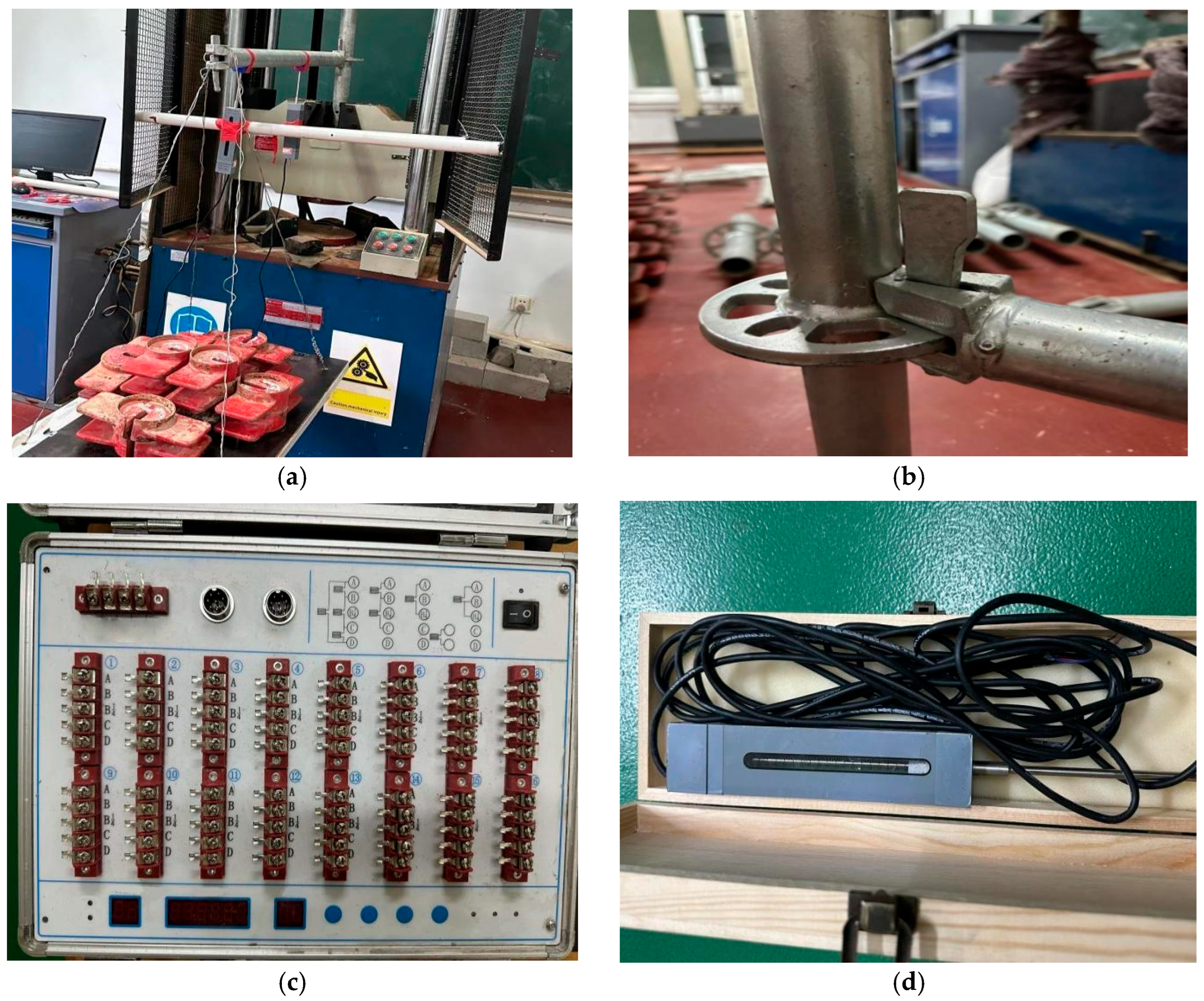


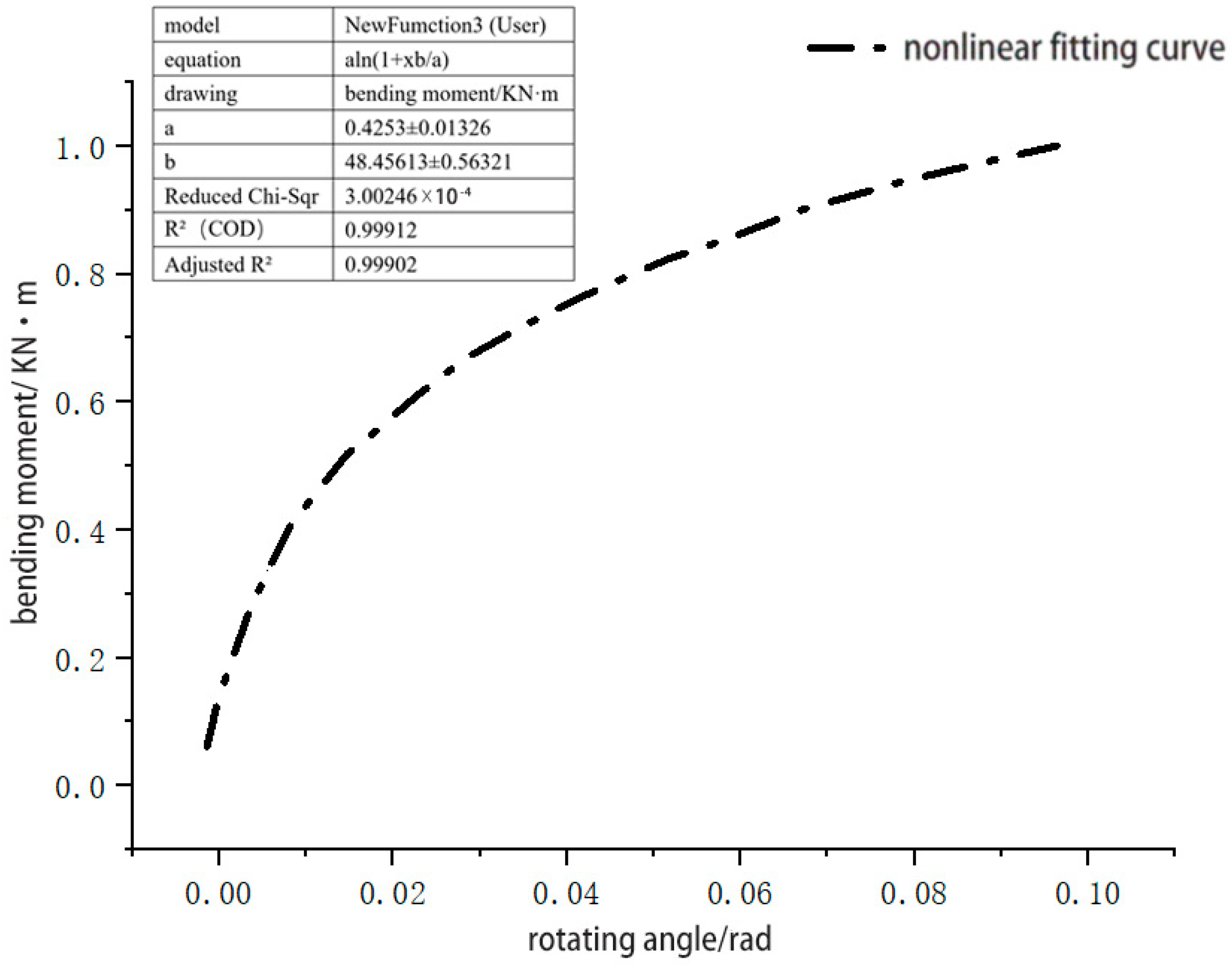
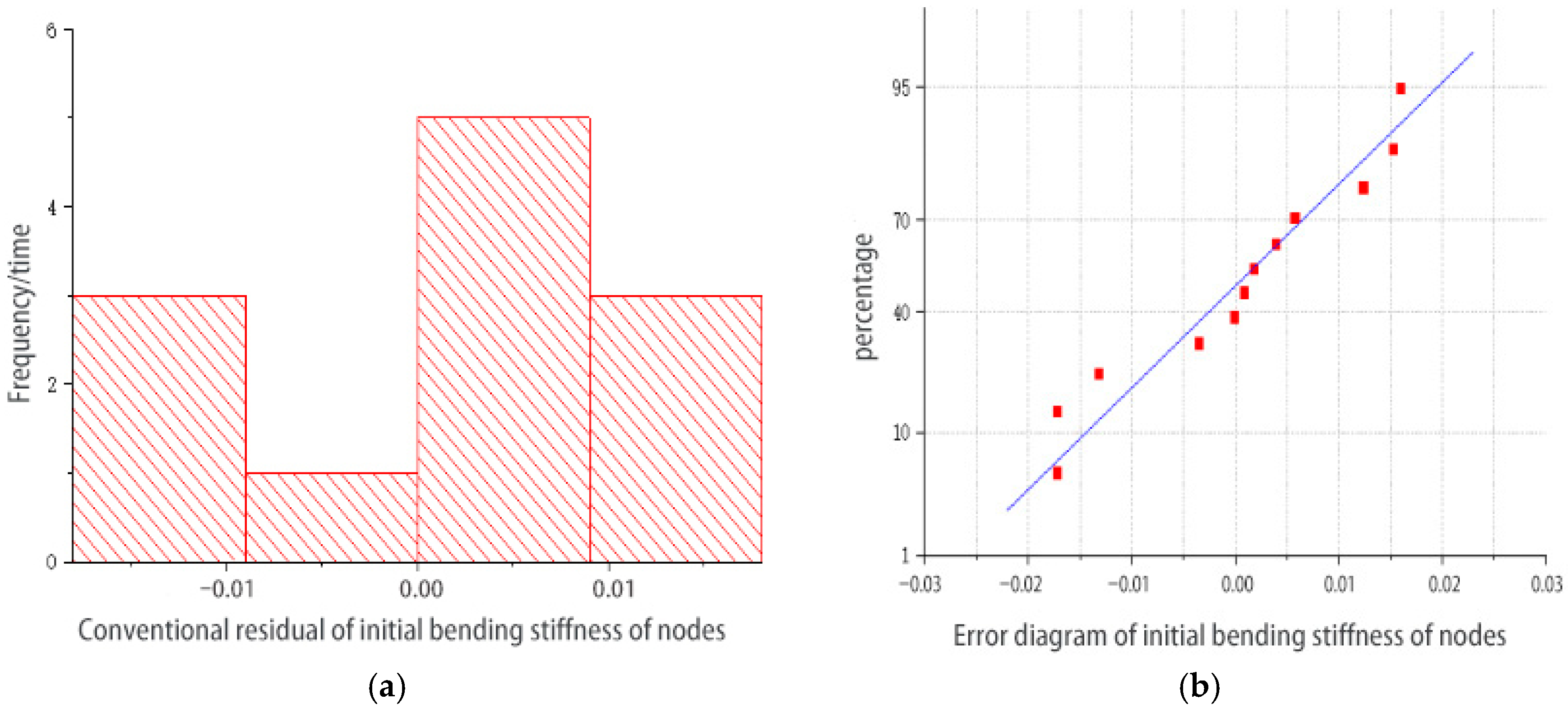
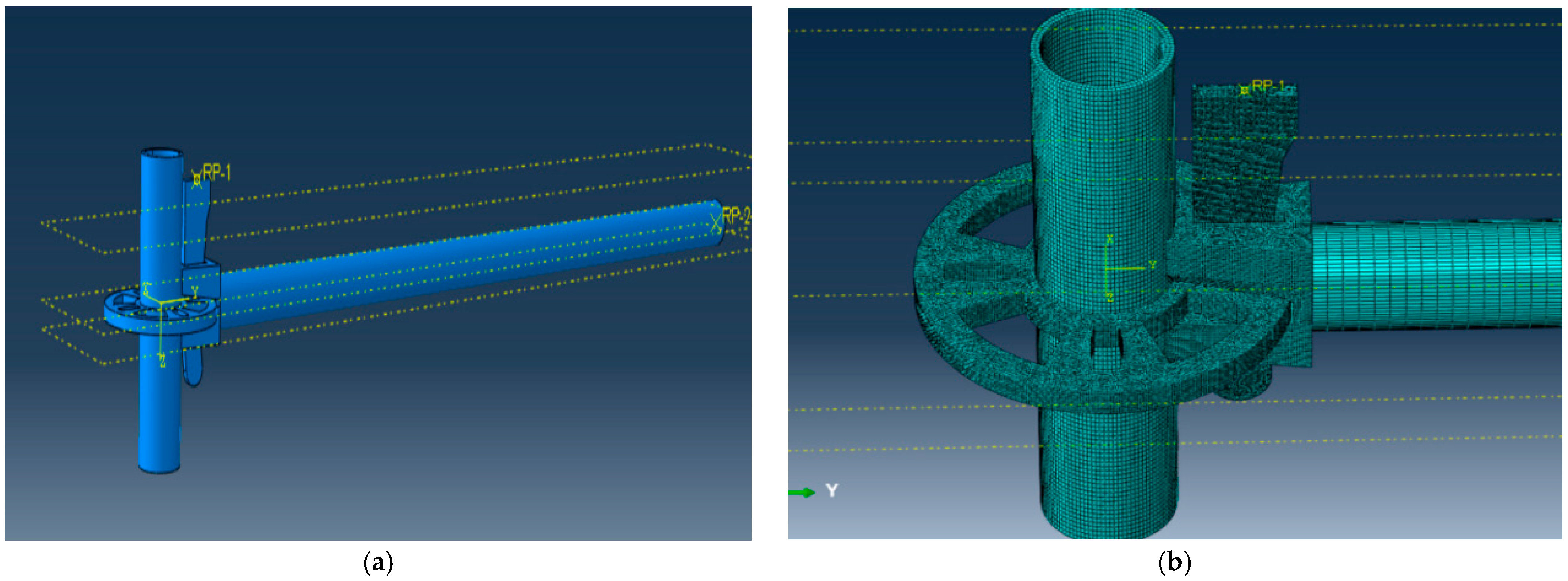
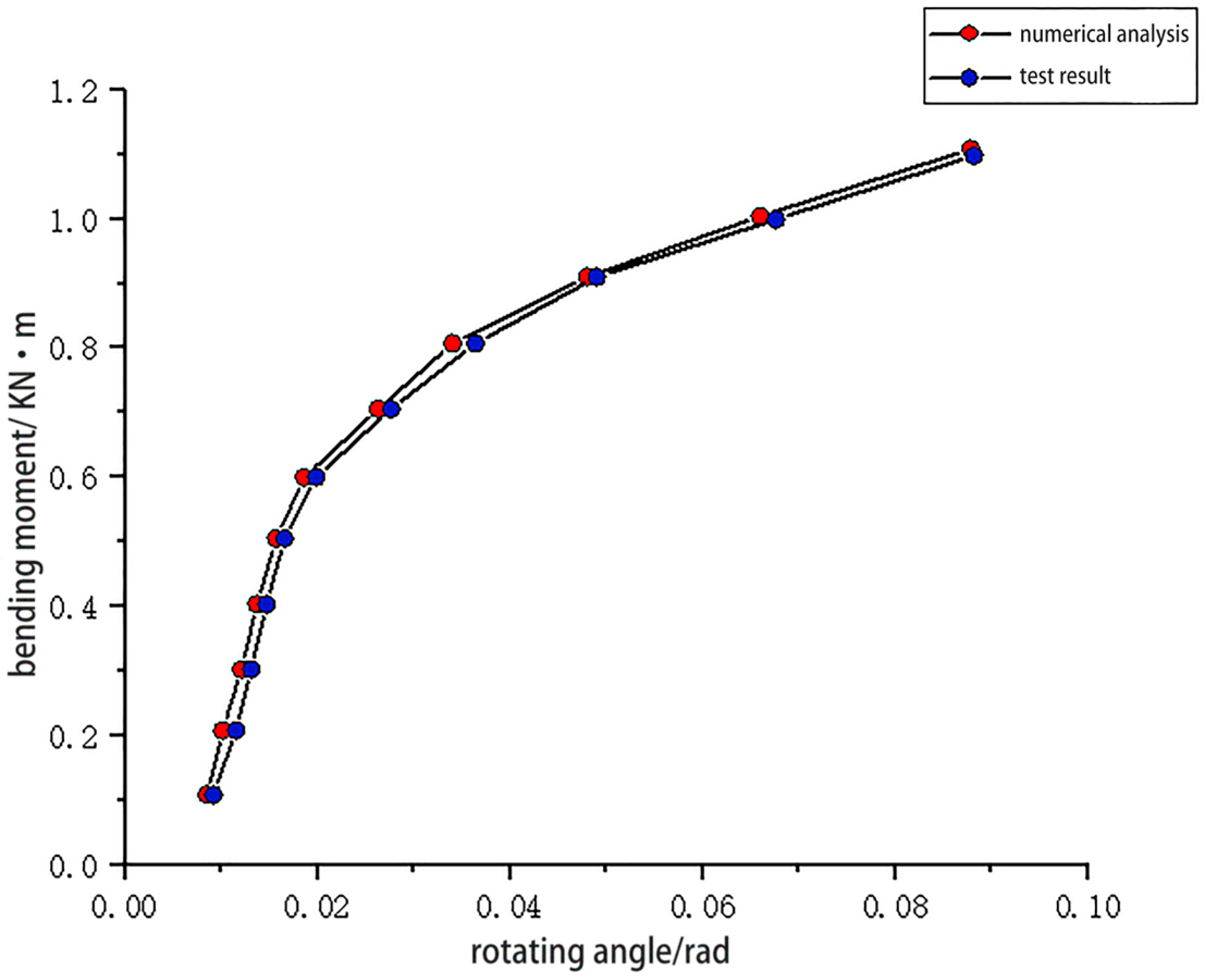

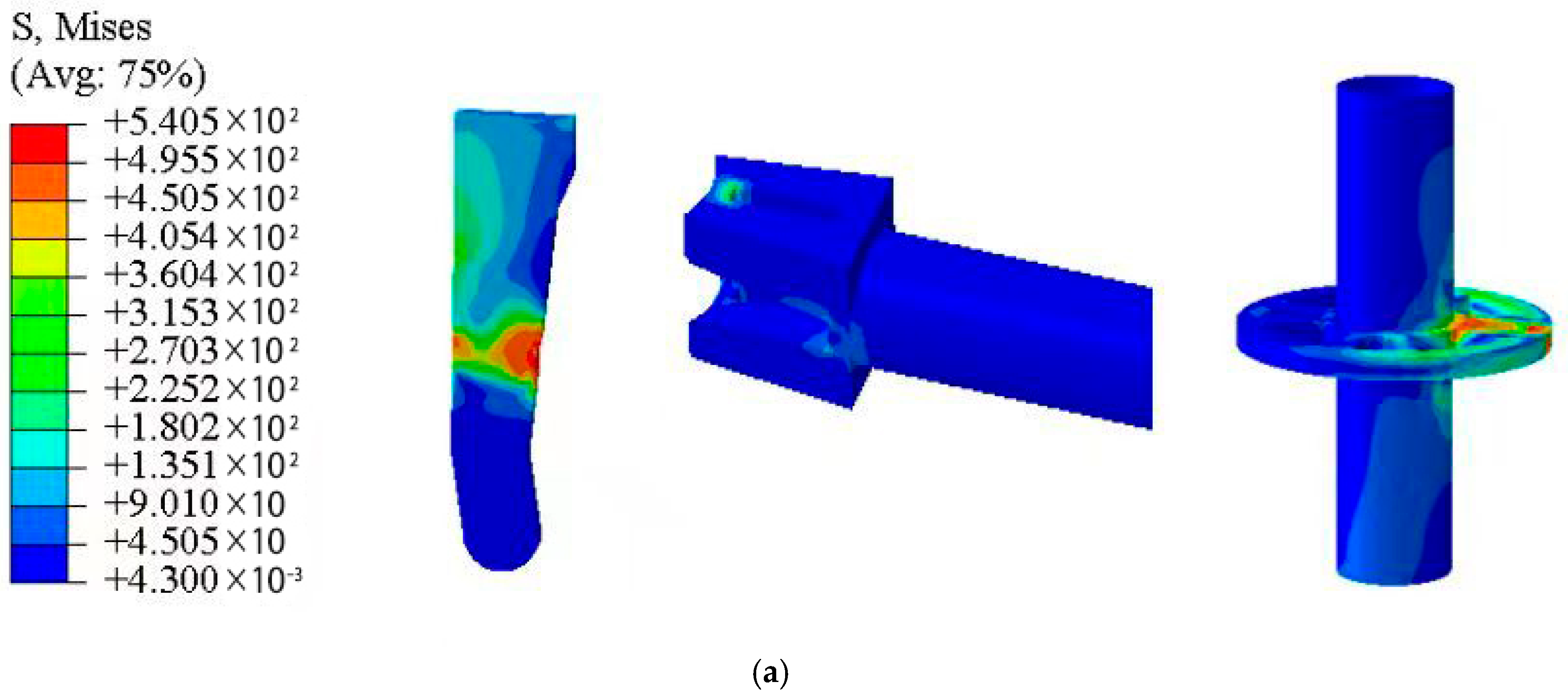


| Component Name | Upright Stanchion | Crossbar | Connecting Disc | Bolt |
|---|---|---|---|---|
| Specification/mm | 48 × 3.2 | 48 × 2.5 | 130 × 10 | 5 |
| material quality | Q345A | Q235B | Q235B | Q235B |
| Type | Specification/mm | Length/m | Sectional Moment of Inertia/m4 | Elastic Modulus/kN·m2 |
|---|---|---|---|---|
| Pillars | 0.5, 1.0, 1.5, 2.0 | 11.36 × 10−8 | 2.06 × 10−8 | |
| 0.3, 0.6, 0.9, 1.2, 1.5, 1.8 | 9.28 × 10−8 | 2.06 × 10−8 | ||
| Crossbar | 0.5, 1.0, 1.5, 2.0 | 11.36 × 10−8 | 2.06 × 10−8 | |
| 0.3, 0.6, 0.9, 1.2, 1.5, 1.8 | 9.28 × 10−8 | 2.06 × 10−8 |
| Working Condition | Step/m | Horizontal and Vertical Distance/m | Correction Factor/ |
|---|---|---|---|
| 1 | 0.5 | 0.3 | 1.7015 |
| 2 | 0.5 | 0.6 | 1.7419 |
| 3 | 0.5 | 0.9 | 1.7836 |
| 4 | 0.5 | 1.2 | 1.8153 |
| 5 | 0.5 | 1.5 | 1.8471 |
| 6 | 0.5 | 1.8 | 1.8859 |
| 7 | 1.0 | 0.3 | 1.2779 |
| 8 | 1.0 | 0.6 | 1.3388 |
| 9 | 1.0 | 0.9 | 1.3982 |
| 10 | 1.0 | 1.2 | 1.4561 |
| 11 | 1.0 | 1.5 | 1.5127 |
| 12 | 1.0 | 1.8 | 1.5680 |
| 13 | 1.5 | 0.3 | 1.2653 |
| 14 | 1.5 | 0.6 | 1.2876 |
| 15 | 1.5 | 0.9 | 1.3017 |
| 16 | 1.5 | 1.2 | 1.3212 |
| 17 | 1.5 | 1.5 | 1.3514 |
| 18 | 1.5 | 1.8 | 1.3790 |
| 19 | 2.0 | 0.3 | 1.0078 |
| 20 | 2.0 | 0.6 | 1.1102 |
| 21 | 2.0 | 0.9 | 1.1497 |
| 22 | 2.0 | 1.2 | 1.1733 |
| 23 | 2.0 | 1.5 | 1.1950 |
| 24 | 2.0 | 1.8 | 1.2179 |
Disclaimer/Publisher’s Note: The statements, opinions and data contained in all publications are solely those of the individual author(s) and contributor(s) and not of MDPI and/or the editor(s). MDPI and/or the editor(s) disclaim responsibility for any injury to people or property resulting from any ideas, methods, instructions or products referred to in the content. |
© 2025 by the authors. Licensee MDPI, Basel, Switzerland. This article is an open access article distributed under the terms and conditions of the Creative Commons Attribution (CC BY) license (https://creativecommons.org/licenses/by/4.0/).
Share and Cite
Zeng, F.; Zou, G.; Ji, M.; Zhang, J. Study on Semi-Rigid Joint Performance and Stability Bearing Capacity of Disc-Type Steel Pipe Support. Buildings 2025, 15, 1955. https://doi.org/10.3390/buildings15111955
Zeng F, Zou G, Ji M, Zhang J. Study on Semi-Rigid Joint Performance and Stability Bearing Capacity of Disc-Type Steel Pipe Support. Buildings. 2025; 15(11):1955. https://doi.org/10.3390/buildings15111955
Chicago/Turabian StyleZeng, Fankui, Guoxin Zou, Meng Ji, and Jianhua Zhang. 2025. "Study on Semi-Rigid Joint Performance and Stability Bearing Capacity of Disc-Type Steel Pipe Support" Buildings 15, no. 11: 1955. https://doi.org/10.3390/buildings15111955
APA StyleZeng, F., Zou, G., Ji, M., & Zhang, J. (2025). Study on Semi-Rigid Joint Performance and Stability Bearing Capacity of Disc-Type Steel Pipe Support. Buildings, 15(11), 1955. https://doi.org/10.3390/buildings15111955





